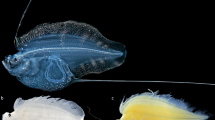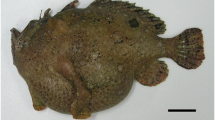Abstract
The first record of a lionfish larva Pterois volitans (Linnaeus 1758) collected from the ichthyoplankton in the Atlantic was found within the Yucatan current off the Western Caribbean, near Cancun, Mexico. The postflexion larva measured 8 mm standard length and was collected using a neuston net aboard the NOAA Ship Gordon Gunter on April 10, 2010. Published morphological and meristic characters were initially used for identification; genetic verification using mtDNA followed. The larva showed 3 distinct pigments beneath the parietal spines that were not included in the original larval description of the species. Ageing of sagittal otoliths exhibited 15–16 daily increments indicating a possible spawn in late March. Given that adult lionfish are established along the Mesoamerican barrier reef, oceanographic patterns suggest that the likely origin of this larva may have been from the southern coast of the Mexican Caribbean to Belize or even Honduras. The Yucatan Current is a rapid means for the potential dispersal of lionfish larvae into the Gulf of Mexico and southern Florida.




Similar content being viewed by others
References
Aguilar-Perera A, Tuz-Sulub A (2010) Non-native, invasive red lionfish (Pterois volitans [Linnaeus 1758]: Scorpaenidae), is first recorded in the southern Gulf of Mexico, of the northern Yucatan peninsula, Mexico. Aquat Invas 5(2):9–12
Ahrenholz DW, Morris JA Jr (2010) Larval duration of the lionfish, Pterois volitans along the Bahamian archipelago. Environ Biol Fish 88:305–309. doi:10.1007/s10641-010-9647-4
Amante C, Eakins BW (2009) ETOPO1 1 Arc-Minute global relief model: procedures, data sources and analysis. NOAA Tech. Mem. NESDIS NGDC-24
Badan AJ, Candela J, Sheinbaum J, Ochoa J (2005) Upper-layer circulation in the approaches to Yucatan channel. In: Sturges WS, Lugo-Fernández A (eds) Circulation in the Gulf of Mexico: observations and models. Geophysical monograph series 161. American Geophys Un, Washington, pp 57–69
Centurioni LR, Niiler P (2003) On the surface currents of the Caribbean sea. Geophys Res Lett 30:1279. doi:10.1029/2002GL016231
Cetina P, Candela J, Sheinbaum J, Ochoa J, Badan A (2006) Circulation along the Mexican Caribbean coast. J Geophys Res 111(C8):1–19. doi:10.1029/2005JC003056
Chérubin LM, Kuchinke C, Paris CB (2008) Ocean circulation and terrestrial runoff dynamics in the Mesoamerican region. Coral Reefs 27:503–519. doi:10.1007/s00338-007-0348-1
Cowen RK, Sponaugle S (2009) Larval dispersal and marine population connectivity. Ann Rev Mar Sci 1(1):443–466. doi:10.1146/annurev.marine.010908.163757
Emilsson I (1971) Note on the countercurrent in the Yucatan Channel and the western Cayman sea. Geofis Int 11:139–149
Imamura H, Yabe M (1996) Larval record of a red firefish, Pterois volitans, from northwestern Australia (Pisces: Scorpaeniformes). Bull Fac Fish Hokkaido Univ 47:41–46
Lasso-Alcalá OM, Posada JM (2010) Presence of the invasive red lionfish, Pterois volitans (Linnaeus 1758), on the coast of Venezuela, southeastern Caribbean sea. Aquat Invas 5(2):53–59
Morris JA Jr, Akins JL (2009) Feeding ecology of invasive lionfish (Pterois volitans) in the Bahamian archipelago. Environ Biol Fish 86:389–398
Morris JA Jr (2009) Biology and ecology of the invasive Indo-Pacific lionfish. Dissertation, North Carolina State University
Morris JA Jr, Whitfield PE (2009) Biology, ecology, control and management of the invasive Indo-Pacific lionfish: an updated integrated assessment. NOAA Tech. Mem. NOS NCCOS 99
Morris JA Jr, Sullivan CV, Govoni JJ (2011) Oogenesis and spawn formation in the lionfish Pterois miles and Pterois volitans. Sci Mar 75:147–154
Ochoa J, Sheinbaum J, Badan A, Candela J, Wilson D (2001) Geostrophy via potential vorticity inversion in the Yucatan Channel. J Mar Res 59:725–747
Richardson P (2005) Caribbean current and eddies as observed by surface drifters. Deep Sea Res II 52:429–463
Rousset C, Beal LM (2010) Observations of the Florida and Yucatan Currents from a Caribbean cruise ship. J Phys Oceanogr 40(7):1575–1581. doi:10.1175/2010JPO4447.1
Schofield PJ (2009) Geographic extent and chronology of the invasion of non-native lionfish (Pterois volitans [Linnaeus 1758] and P. miles [Bennett 1828] in the western north Atlantic and Caribbean sea. Aquat Invas 4:473–479
Schofield PJ (2010) Update on geographic spread of invasive lionfishes (Pterois volitans [Linnaeus 1758] and P. miles [Bennett 1828]) in the western north Atlantic ocean, Caribbean sea and Gulf of Mexico. Aquat Invas 5:S117–S122
Schultz ET (1986) Pterois volitans and Pterois miles: two valid species. Copeia 1986:686–690
Soto I, Andréfouët S, Hu C, Muller-Karger FE, Wall CC, Sheng J, Hatcher BG (2009) Physical connectivity in the Mesoamerican barrier reef system inferred from 9 years of ocean color observations. Coral Reefs 28(2):415–425. doi:10.1007/s00338-009-0465-0
Walsh PS, Metzger DA, Higuchi R (1991) Chelex 100 as a medium for simple extraction of DNA for PCR-based typing from forensic material. Biotechniques 10:506–513
Whitfield PE, Gardner T, Vives SP, Gilligan MR, Courtenay WR Jr, Ray GC, Hare JA (2002) Biological invasion of the Indo-Pacific lionfish Pterois volitans along the Atlantic coast of north America. Mar Ecol Prog Ser 235:289–297
Acknowledgments
We acknowledge the captain and crew of the R/V Gordon Gunter for sample collection and D. Drass, D. Acevedo, J. Cohuo, M. Yescas, as well as scientists from NOAA (United States), INAPESCA (Mexico), and ECOSUR (Mexico) that participated in the survey. We also thank W. Nagel for assistance with genetic analysis and D. Ahrenholz, J. Smith, P. Mararro, and M. Fonseca for assistance with manuscript review. Support and analyses for the cruise were partially funded by ECOSUR, the University of Miami-CIMAS, the NASA Biodiversity and Ecological Forecasting program, and NOAA.
Author information
Authors and Affiliations
Corresponding author
Rights and permissions
About this article
Cite this article
Vásquez-Yeomans, L., Carrillo, L., Morales, S. et al. First larval record of Pterois volitans (Pisces: Scorpaenidae) collected from the ichthyoplankton in the Atlantic. Biol Invasions 13, 2635–2640 (2011). https://doi.org/10.1007/s10530-011-9968-z
Received:
Accepted:
Published:
Issue Date:
DOI: https://doi.org/10.1007/s10530-011-9968-z




